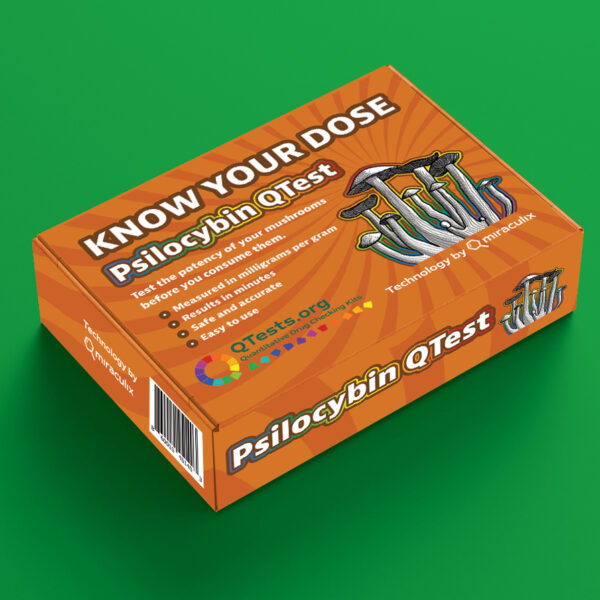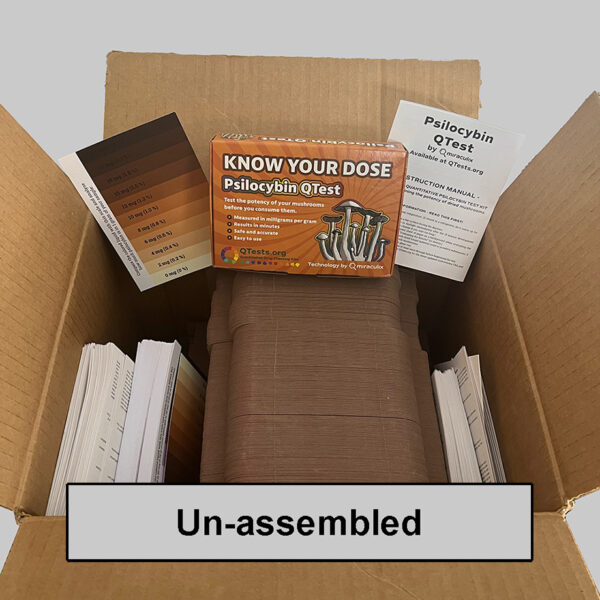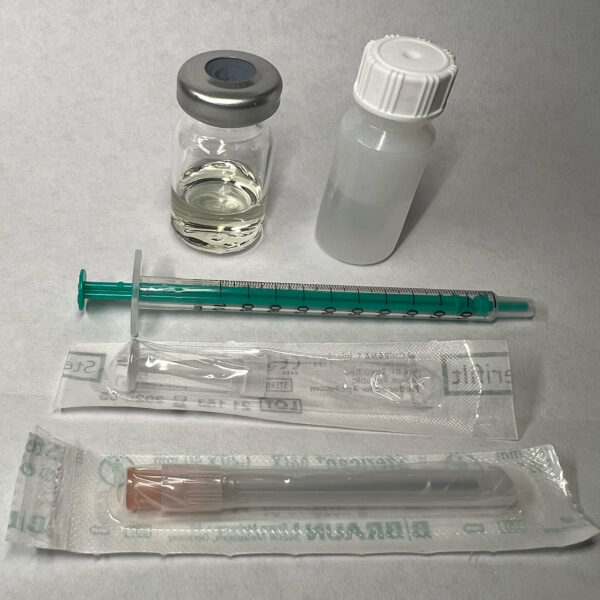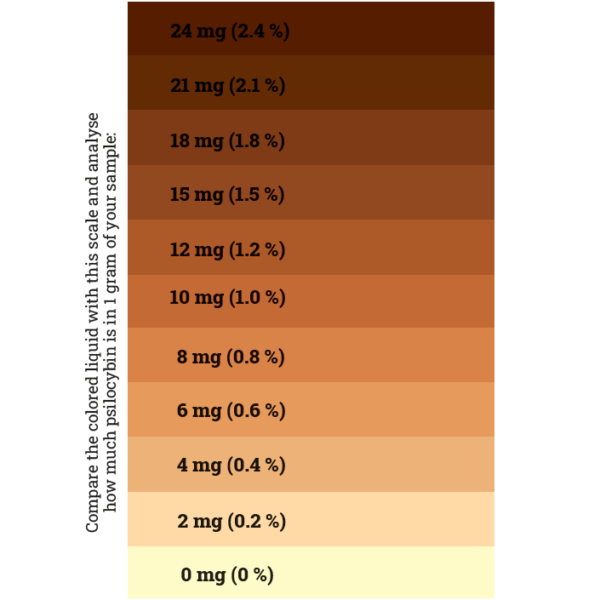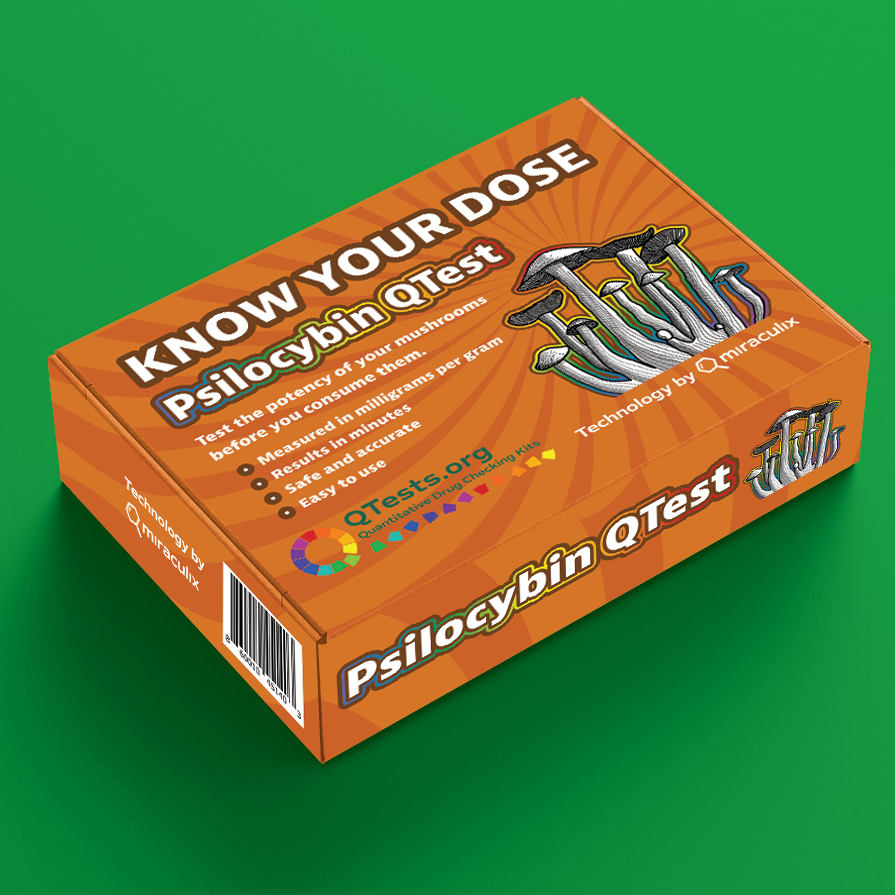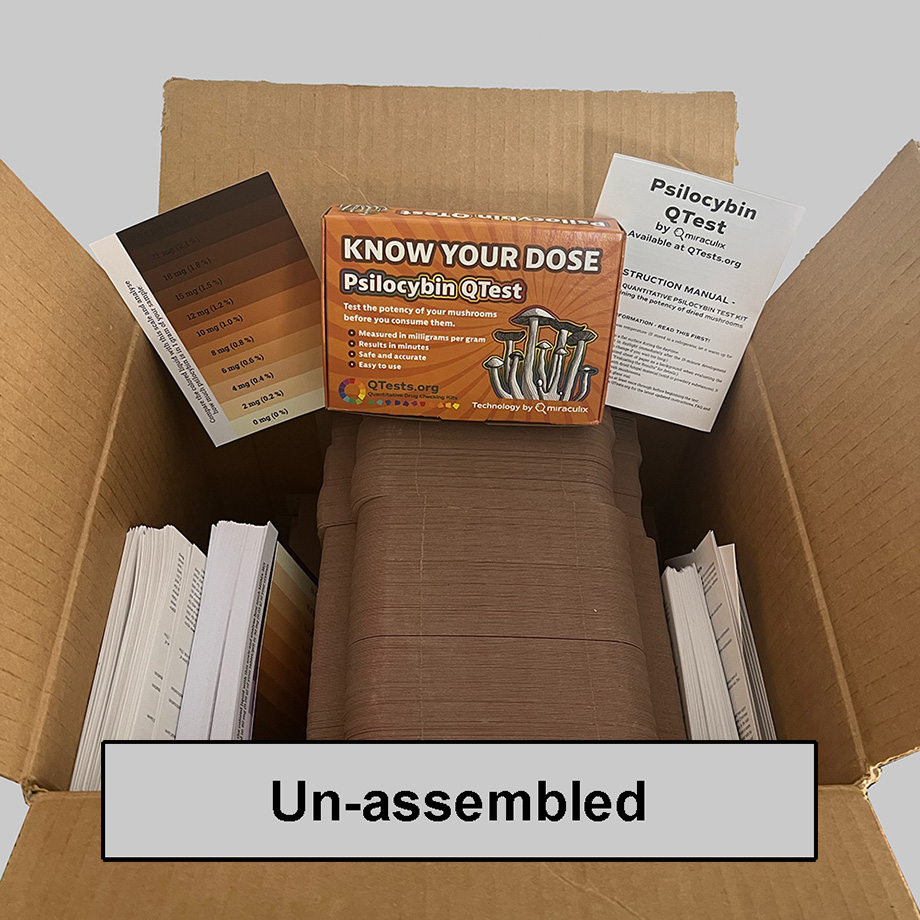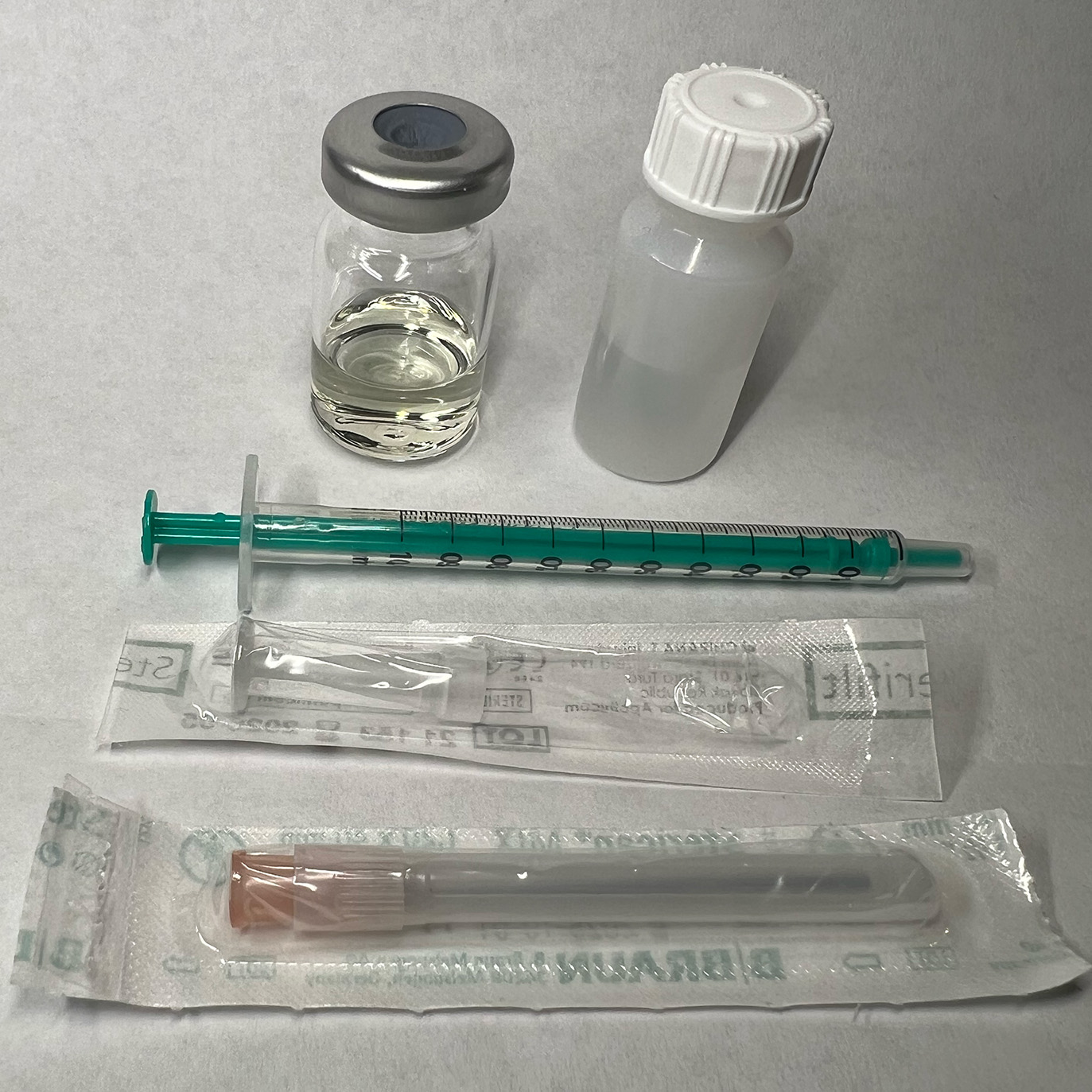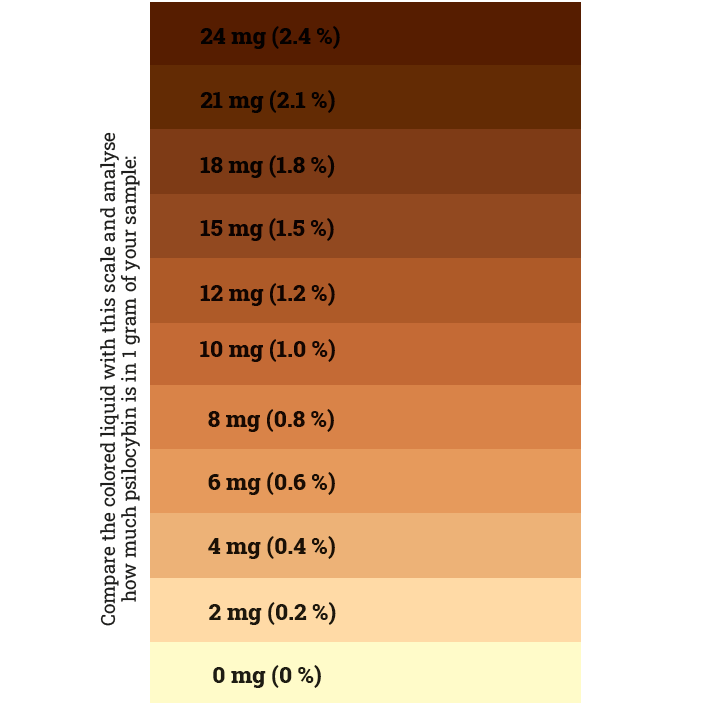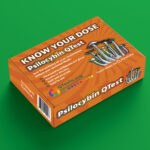Psilocybin QTest
$24.95
Know Your Dose! The potency of psilocybin-containing mushrooms can vary tremendously between species, variety and batch. This is true even for cultivated varieties. With our Psilocybin QTest, you can quickly and easily determine the potency of any batch of dried mushrooms. Results are given both as a percentage of psilocybin and as an exact numerical ratio in milligrams per gram.
- Results in 30 minutes.
- Only 150 mg of starting material required.
- Easy evaluation with the enclosed color chart.
- The only quantitative psilocybin test kit on the market.
Automatic Bulk Discounts
Get 20% off when you buy five or more QTests.
- Description
- Instructions
- FAQ
Description
Know your dose with the Psilocybin QTest
The Psilocybin QTest is the first and only test kit on the market that can tell you the potency of magic mushrooms. Works with dried mushrooms and extracts.
This single-use kit can be used to test any amount of mushrooms you want, so long as they are dried and you grind them up first.
Simply follow the instructions and compare the color of the detection vial to the enclosed color chart.
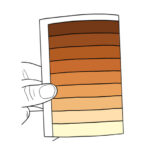
It’s that simple.
Instructions
Instructions
Note: A paper version of these instructions comes with your order.
IMPORTANT INFORMATION! – READ THIS FIRST
• Use this kit at room temperature. (If stored in a refrigerator, let it warm up for one hour first.)
• Perform the test on a flat surface during the daytime. Evaluate the result in daylight immediately after the 15-minute development time. (The color can change if you wait too long.)
• Use a white, letter-sized sheet of paper as a background when evaluating the color. (See section 4, ”Evaluating the Results” for details.)
• This kit only works with dried fungal material (solid or powdery substances). It does not work with fresh mushrooms.
• Do not open the sealed, glass vial.• Read all the instructions at least once through before beginning the test.
1. BACKGROUND INFORMATION
Psilocybin is the main active ingredient naturally present in live fungal tissue. When mushrooms are dried and stored correctly, the psilocybin is preserved. However, so- metimes some of the psilocybin will degrade into psilocin. Psilocin is also an active ingredient. It’s only when mushrooms are dried and stored incorrectly for a long pe- riod of time that the psilocin further degrades into inactive compounds, reducing the potency of the mushrooms.
The Psilocybin QTest totals the amount of both active ingredients (psilocybin and psilocin) in your fungal sample. Although we present the total in terms of psilocybin only—because this is the most well-known alkaloid—rest assured the results give you the actual potency of your mushrooms, including both psilocybin and psilocin.
IMPORTANT! This kit should only be used on dried mushroom material (e.g., myceli- um, fruiting bodies, sclerotia “truffles”) or dried extracts.
DID YOU KNOW? All psilocybin is converted into psilocin in your body, and it’s the psilocin that causes the trip. This is why psilocybin is considered a “prodrug.” It is not biologically active until it converts into psilocin.
2. PREPARING FOR THE TEST
Take out all the items from your kit. Along with these instructions, you should have:
• protective gloves
• plastic extraction vial with a screw cap
• glass vial with a tightly sealed lid and septum
• 1 ml syringe
• syringe filter tip (Sterifilt)
• blunt needle
• evaluation color chart
You will also need a milligram scale, a pot to boil water, a pair of kitchen tongs, and either a small funnel or a creased piece of paper to carefully pour the mushroom material into the extraction vial. (You can make your own paper funnel. Google it!)
Before you begin the test you must homogenize your dried mushroom material. A coffee grinder works best. If you do not have a coffee grinder then you can chop your mushrooms finely on a cutting board using a sharp knife. (Starting off with a pair of scissors can make chopping easier.) Then mix the chopped material thoroughly.
You will be using 150 milligrams (mg) of material for the test. The result will tell you
the percentage of psilocybin per gram in remaining material (in terms of mg/gram). But you must homogenize the material first as described above. This is because psilocybin is not naturally distributed evenly inside of mushrooms. One mushroom can have ten times more or less psilocybin than another mushroom from the same batch. Even within a single mushroom the concentration of psilocybin can vary greatly. Therefore, if you don’t homogenize your material first, the test result will not be accurate for all your remaining material.
You can homogenize as much material as you want, but keep in mind that ground up mushrooms will degrade more quickly than whole mushrooms. Keeping them completely dry, sealed, and frozen (“freeze-dried”) will preserve the alkaloids best.
3. PERFORMING THE TEST
3.1 First put on the enclosed nitrile gloves and wear appropriate protective clothing and safety glasses. If you wear contact lenses, remove them. The liquids in the vials con- tain acids which may cause skin irritation or severe eye damage. In the event you come in contact with the liquid, remove the affected clothing immediately and rinse the affected skin area with water for several minutes. In case of eye contact, rinse the affected eye with running water for several minutes. (Keep pets, especially cats, away from the testing area.)
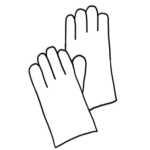
3.2 Carefully weigh 150 mg (0.150 g) of your homogenized material using a milligram scale. For concentrated extracts, use a proportionally lower amount (so that the results fit into the range of the color chart). For example, weigh out 75 mg of material for a 2X extract. Weigh out 15 mg of material for a 10X extract. (You will then need to multiply by the same factor at the end. This will be explained later.)
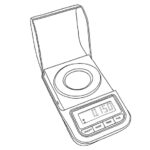
3.3 Preheat around one liter of water (about four cups) in a pot or kettle on the stove or in a kettle. When the water boils, turn off the stove. (This will save you time when you need to boil the water later in step 3.7.)
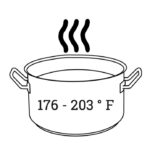
3.4 Open the plastic extraction vial and carefully pour in your mushroom material using a small funnel or creased piece of paper. Screw the lid back on tightly and shake the vial for approximately ten seconds. Then put the vial down and wait for 10 minutes. During this waiting period, repeat the shaking process two more times, once at about three minutes, and again around seven minutes. Make sure the vial rests motionless for a few minutes before proceeding to the next step. This allows the particulates to settle and makes it easier to draw up liquid into the syringe through the filter tip.
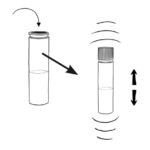
3.5 Unpack the syringe and the syringe filter tip. Attach the filter tip to the syringe. Remove the lid from the plastic vial. Hold the vial with one hand and with your other hand insert the syringe into the vial. Pull the syringe plunger completely open and hold it there. This will create negative pressure and the syringe will slowly fill up with 1 ml of liquid. Remove the syringe from the plastic vial and disconnect the filter tip. Now unpack the blunt needle, remove its plastic casing and attach it to the syringe.
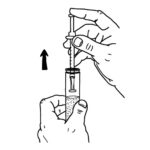
3.6 Pierce the septum of the glass vial using the blunt needle and inject the entire liquid into the vial evenly with moderate pressure. (Penetrating the septum with the blunt needle requires some force, but protects you from injury.) Make sure that the tip of the syringe does not touch the liquid in the glass vial. Then, before removing the empty syringe, completely fill it with air. This depressurizes the vial and prevents liquid from splashing out when removing the syringe.
Remove the syringe and blunt needle from the glass vial. (The liquid in the glass vial may now have a greenish color. This indicates the presence of psilocin in the sample, but does not provide a quantitative result. You still need to incubate the vial in hot water.)
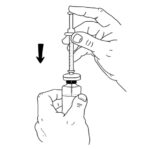
3.7 Heat the water again until it boils. Now remove the pot from the heat source and turn off the stove. The water in the pot should no longer be boiling. It is now at the right temperature. Place the glass vial into the water using a pair of kitchen tongs and incubate it for 15 minutes. (It is okay to completely submerge the vial. Water will not enter through the septum.)
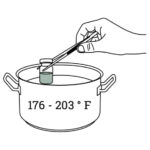
3.8 The solution in the vial will start to change color. After 15 minutes, carefully remove the vial from the water using the kitchen tongs. Be careful not to touch the glass vial with your fingers until it cools down. After a few minutes it will be cool enough to touch. Use the en- closed evaluation color chart to determine the potency of your homogenized material. See the next section, “EVALUATING THE RESULT,” for details.

4. EVALUATING THE RESULT
Follow the instructions above before evaluating the result. The evaluation should only take place after the vial has incubated for 15 minutes in the water bath.
By comparing the intensity or saturation of the liquid in the vial with the enclosed color chart, you can determine the result visually. Daytime sunlight is best suited for optimal evaluation. If using artificial light, the influence of different color temperatu- res may slightly change the hue. You can still perform the evaluation, but you should take this into account (e.g. high blue content in energy-saving lamps, green discolo- ration when using LED light from cell phones, etc).
SPECIFIC EVALUATION INSTRUCTIONS
• Use a white, letter-sized sheet of paper as a background.
• In daylight or under bright light, hold the glass vial next to the color chart about six to eight inches in front of the white sheet of paper and look through the glass vial head-on. For best results, your eyes should be fairly close to the vial, but no closer than about six to eight inches.
• Now compare the color of the liquid in the vial to the color chart. The corre- sponding concentration of psilocybin/psilocin is listed as a percentage as well as a ratio in terms of milligrams per gram of material (mg/gram).
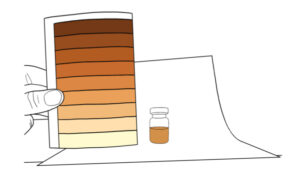
• This concentration applies to your remaining homogenized material.
• For extracts, you need to multiply by the same factor that you reduced your starting material at the beginning of the process. For example, if you tested a 2X extract and reduced your starting material by a factor of two (75 mg instead of 150 mg), then you need to multiply by two to obtain the correct result. Simi-
larly, if you tested a 10X extract (using 15 mg), you will need to multiply by ten.
• Do not evaluate the liquid after four hours. At this time the color may no longer be reliable.
5. STORAGE AND SHELF LIFE
Store the reagents in the refrigerator (35 – 46 F) and out of direct sunlight for a shelf life of at least 18 months. The extraction liquid may turn slightly yellow over time. That’s okay. It is still usable.
6. WARNINGS
• Keep the kit away from children and animals.
• When performing the test, wear suitable protective gloves, clothing, and face/eye protection. If you wear contact lenses, remove them before using the test kit.
• The liquids contained in the test kit consist of various acids which may cause a corrosive/irritating effect on the skin or severe eye damage/irritation. Avoid contact with the skin, eyes, mouth or clothing.
• Should contact with the above-listed areas occur, remove the relevant clothing immediately. Instantly rinse the affected skin areas with water for several mi- nutes. In case of contact with the eyes, immediately rinse them with water for several minutes using both hands to keep the upper and lower eyelids open.
• Substances processed with the test kit are not to be consumed!
7. DISCLAIMERS
• The result may not be 100 % accurate. Your sample could be adulterated with one or more unknown substances that cross-react with the reagents, affecting the quantitative result.
• The result does not mean your sample is safe to consume. It could still contain unwanted substances and impurities that can be harmful or even deadly.
• The result does not serve as an identification for the species of mushroom. Psilocybin mushrooms can have a similar appearance to poisonous mushrooms. Mushrooms that do not contain psilocybin could cross-react with the reagents and produce minor stainings. This is a false positive reaction presumably to reactive indole.
• The Psilocybin QTest is not a substitute for laboratory analysis.
• mIraculix and/or Qtests.org assume no responsibility for the use or misuse of
the test kit or the results.
9. DISPOSAL OF MATERIALS
Check your local regulations for proper disposal of acids.
FAQ
Coming soon

